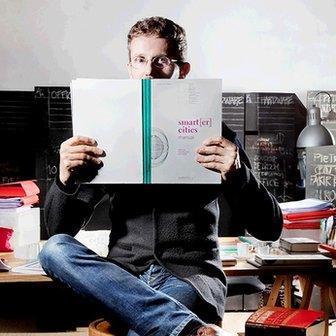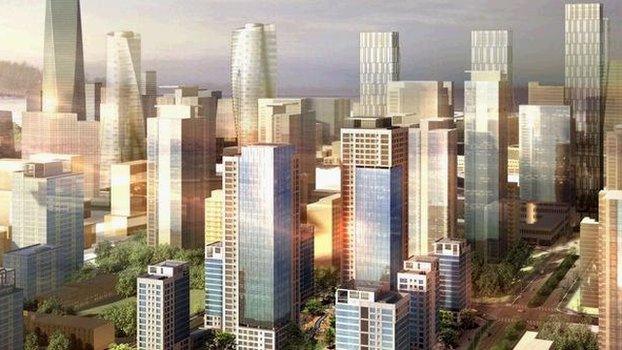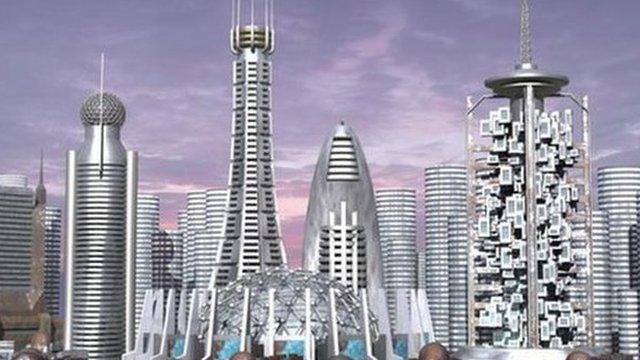Tomorrow's cities: What's it like to live in a smart city?
- Published
London: City of the future
As we head towards a new era of urbanisation - half of the world's population will live in cities by 2050 - the race is on to make our cities fit for purpose.
Technology is playing a bigger role in helping to make city life run more smoothly, from networks of sensors that offer information about how traffic is flowing or where water pipes are leaking to apps designed to help citizens get the most out of their city.
But what does it actually mean to live in a city overtaken by technology? And is it a future we even want?
The BBC asked a range of experts to describe life in their own smart city.
Anthony Townsend

Unlike the smart cities popping up in Asia and the Middle East, New York's digital transformation has almost gone without notice.
Because unlike in the past, when urban upgrades called for large-scale physical changes - laying rail lines, ploughing expressways through neighbourhoods - getting smart entails fitting out tiny gadgets by the millions, that mostly work invisibly, behind the scenes.
But that doesn't mean you can't see them.
To the trained eye, this hidden layer of intelligent infrastructure can be found on any street corner in Manhattan.
An array of antennae and cameras dangle over traffic, recently sprouted from the century-old armature of traffic signals.
A grey box the size of a sandwich affixed to each building sends back hourly measures of water consumption to the municipal cloud.
And you don't have to be a city planner to see this transformation unfold in real-time.
Inside my pocket, my phone has become a viewfinder and remote control for the entire city.
Like the Marauder's Map from Harry Potter, I watch as the dots that mark my friends and family scurry around.
With other apps I can adjust the thermostat back at my apartment, summon a taxi to the corner where I stand, or send a noise complaint to my local government.
And as swarms of food delivery boys summoned via apps like Grubhub and Seamless cycle past, I realise I'm not the only one to figure this out.
Prof Carlo Ratti

Singapore - the very name of this small city-state projecting out of the Malay peninsula evokes, to many, the idea of "smart city".
The moment you land at Changi airport you find yourself in a ticking, responsive environment, shimmering with an almost tangible digital awareness.
Highly automated immigration lanes sweep you through in minutes, just enough time to taste one of the sweets waiting on the counter - TSA [Transportation Security Administration] officers at New York City's notorious air gateways please take notice, not only of the sweets.
As you make your way towards the city centre you are directed by one of the world's first dynamic road pricing systems - an idea that has subsequently been imitated in cities around the world, such as London.
Throughout Singapore you find yourself immersed in a symphony of effortless efficiency.
However, a truly "smart city" should also possess other dimensions - it should be a palimpsest of creative, bottom-up civic engagement.
It should - as my friend and colleague Saskia Sassen would put it - allow "hacking" by its smart denizens, empowering them to augment their collective space through the exploding constellation of urban apps.
Perhaps this could be the next "smartness" frontier for Singapore - and for other cities around the world.
Julia Michaels

Back in the 1970s, the map of Rio de Janeiro had white patches.
These represented the city's favelas, or informal settlements.
Planners seemed to hope they'd somehow disappear.
Today, the Operations Centre is working to map and serve the needs of all citizens.
When seasonal torrential rains come, the centre monitors the danger of favela mudslides and puts evacuation measures into effect.
Rio is a much smarter city today, than when I first moved here in 1995.
Until the Operations Centre opened, in 2010, it took an impossible dose of patience for a citizen to report a darkened streetlight, a clogged sewer or a missing trash receptacle.
One agency passed a caller on to the next, then the next, then the next.
Now you can do this on an internet site or by calling a central phone number - and much of the time, the problems are actually addressed.
The centre has at last put the entire city on the map, and watches it carefully, sending out teams to douse fires and redirect traffic.
The information collected had yet to be fully utilised, one expert told me.
And sometimes, it's not as accessible as we'd like.
Last June, would-be protesters went online before leaving home, to scout out the policing presence downtown.
But no images were coming from that area.
Centre administrators say that demand overburdened the site.
- Published2 September 2013

- Published27 August 2013

- Published19 August 2013
